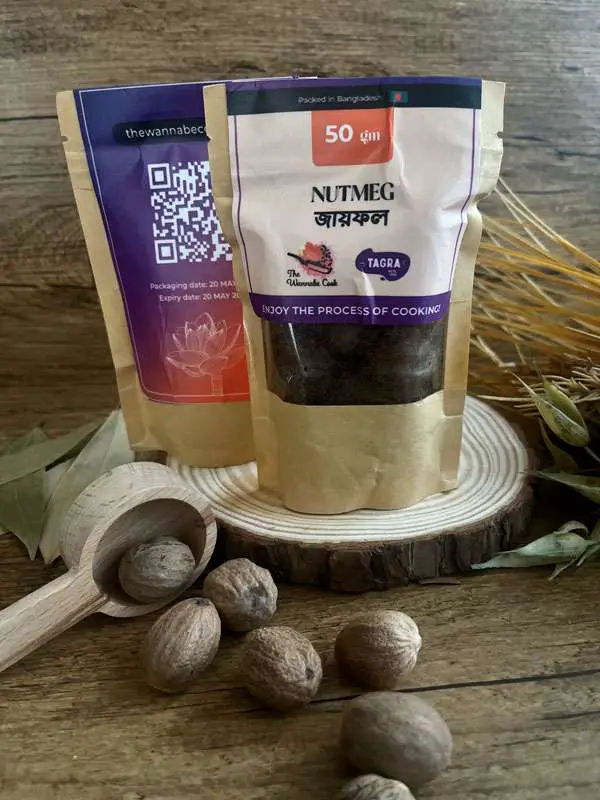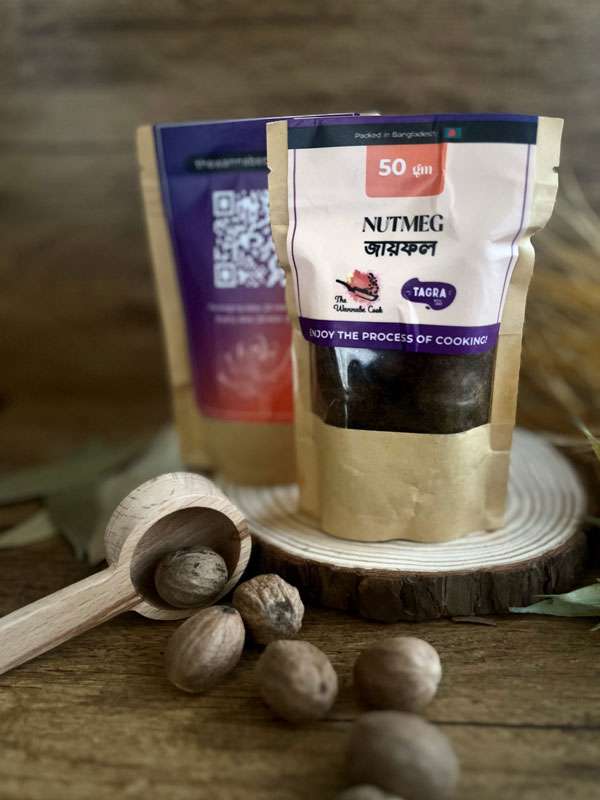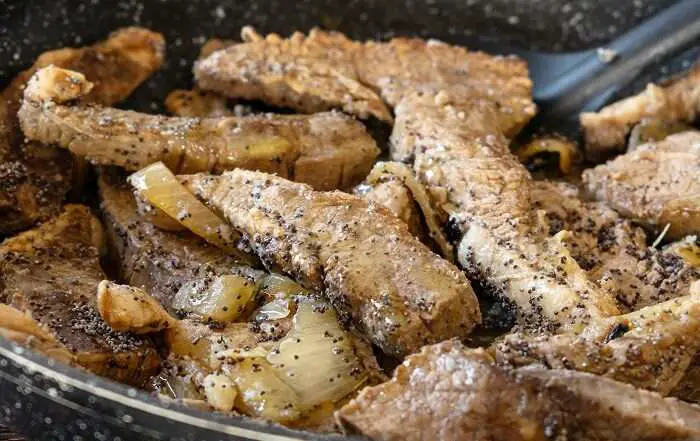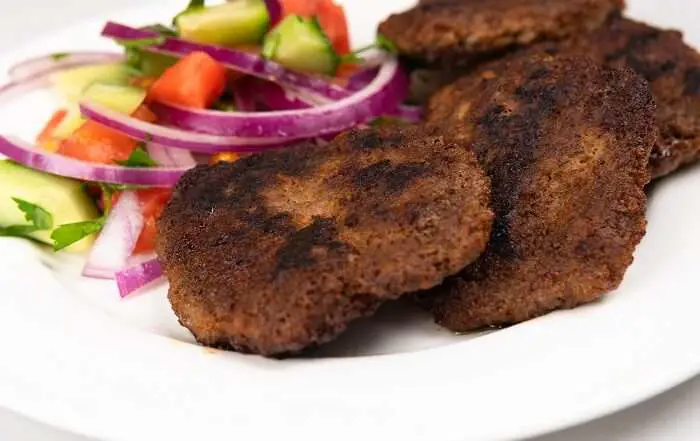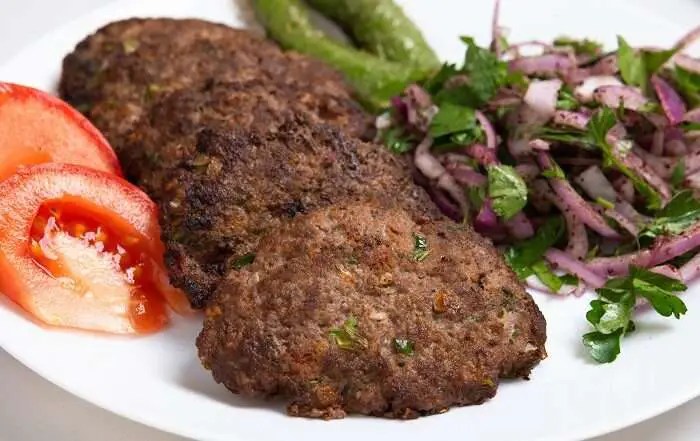Nutmeg is a spice derived from the genus Myristica plant native to both Africa and Eastern Indonesia. Myristica fragrans (fragrant nutmeg) comes from the Indonesian Banda Islands, also known as the Spice Islands, and is among the earliest spices traded in history. As the early spice trade developed along what we now call the Silk Road, nutmeg traveled from those small Indonesian Islands to become a beloved spice heavily used by cultures around the world.
Nutmeg is not a nut but a seed of the Myristica plant. The fragrant nutmeg plant produces a golden-hued, apricot-like fruit. The kernel of that fruit is where nutmeg and mace, the outer skin of the nutmeg kernel called the aril, are sourced. When the nutmeg kernel and arils are fresh, they have a glossy appearance from the oils in the nutmeg. Once they are dried into the spice, they lose their shiny exterior. It takes six to eight weeks of drying in order to prepare the nutmeg seed to be used as a spice.
Some of the key points are:
Geographical Origin: The nutmeg tree is native to the Banda Islands, which are part of the Maluku Province of Indonesia. These islands have a tropical climate that is ideal for the cultivation of nutmeg and mace.
Cultivation: Nutmeg and mace are derived from the seeds of the nutmeg fruit. Mace specifically comes from the aril (the red, lace-like covering) that surrounds the seed inside the fruit. The fruit itself splits open when ripe, revealing the bright red mace covering around the seed.
Historical Trade: The Banda Islands were historically significant during the age of spice trade due to their monopoly on nutmeg and mace production. The Portuguese, Dutch, and later English traders fought fiercely to control these islands because of the high value of these spices in Europe and Asia.
Spread: Over time, nutmeg and mace cultivation spread to other regions with suitable climates, such as Grenada in the Caribbean, where the Dutch introduced them in the 18th century. Today, other countries, including India, Malaysia, and Sri Lanka, also cultivate nutmeg and mace.
Health Benefits
Nutmeg has been traditionally used not only as a spice but also for its medicinal properties. Some potential health benefits of nutmeg include:
Digestive Health: Nutmeg is believed to aid digestion and relieve gastrointestinal discomfort. It may help reduce bloating, gas, and indigestion.
Anti-inflammatory Properties: Nutmeg contains compounds that have anti-inflammatory effects, which may help in reducing inflammation in the body.
Brain Health: Nutmeg contains myristicin and other compounds that have been studied for their potential benefits to brain health. They may help improve cognitive function and protect against neurodegenerative diseases.
Pain Relief: Nutmeg oil, when applied topically or used in aromatherapy, is believed to have analgesic properties and may help relieve muscle pain and inflammation.
Antimicrobial Activity: Nutmeg has shown antimicrobial properties against certain bacteria and fungi, suggesting it may help in fighting infections.
Heart Health: Some studies suggest that nutmeg may have beneficial effects on heart health by lowering blood pressure and supporting overall cardiovascular function.
Dental Health: Nutmeg oil has been used traditionally in dental care due to its antibacterial properties, which may help in maintaining oral hygiene.
It’s important to note that while nutmeg offers potential health benefits, consuming large amounts can be toxic and lead to adverse effects such as hallucinations, nausea, and dizziness. Therefore, it should be used in moderation as a spice rather than as a therapeutic substance. As with any herbal remedy, it’s advisable to consult with a healthcare provider before using nutmeg for medicinal purposes.
Fun Facts
History of Wealth: In the 17th century, nutmeg was so highly valued in Europe that it was worth more by weight than gold, leading to intense competition among European powers to control its production and trade.
Dual Spice: Nutmeg is both a spice and a hallucinogen. Consuming large amounts of nutmeg can produce hallucinogenic effects due to the compound myristicin, although this is not recommended and can be dangerous.
The Nut and the Mace: Nutmeg is the seed of the nutmeg tree, while mace is the red, lace-like substance that covers the seed. Both are used as spices, with nutmeg being more common in culinary uses and mace adding a similar but slightly different flavor.
Symbolism: Nutmeg has been used symbolically in various cultures. It was often given as a gift and represented wealth, fertility, and good luck.
Culinary Uses: Nutmeg is a versatile spice used in both savory and sweet dishes. It adds warmth and depth to dishes like soups, stews, sauces, and baked goods such as pies and custards.
Traditional Medicine: In traditional medicine, nutmeg has been used to treat various ailments such as digestive issues, arthritis, and insomnia, although its efficacy for these purposes varies and should be used cautiously.
Geographical Origins: Nutmeg is native to the Banda Islands of Indonesia, also known as the Spice Islands. It was historically the only place where nutmeg was grown until it was introduced to other tropical regions.
Essential Oil: Nutmeg essential oil is used in aromatherapy for its soothing and relaxing properties. It is also used in perfumes and as a flavoring agent in beverages and confectionery.
These fun facts highlight nutmeg’s rich history, cultural significance, and diverse uses beyond just culinary applications.
Use of Nutmeg in Cooking
Nutmeg is a versatile spice that adds warmth and depth to both sweet and savory dishes.
When using nutmeg, it’s best to use it sparingly as its flavor can be quite potent. Whole nutmeg seeds can be grated using a fine grater or a microplane for the freshest flavor. Nutmeg pairs well with other spices like cinnamon, cloves, and ginger, depending on the recipe and cuisine.
Here are some common uses of nutmeg in cooking.
Level 1: Using Nutmeg as an Immune Fighter
Nutmeg has been traditionally used in various forms for alleviating symptoms associated with colds and flu. Here are some ways nutmeg has been used:
Nutmeg Tea: Nutmeg can be steeped in hot water to make a tea. This method is believed to help soothe sore throats and ease congestion. To make nutmeg tea, grate a small amount of nutmeg into a cup of hot water, let it steep for a few minutes, and then drink it while warm.
Nutmeg Poultice: In some traditional practices, a poultice made from ground nutmeg mixed with water or other soothing ingredients has been applied externally to the chest to relieve congestion.
Warm Nutmeg Milk: Mixing nutmeg with warm milk is a traditional remedy for colds and flu in some cultures. The combination is believed to have soothing properties and can be comforting before bedtime.
Nutmeg in Foods: Nutmeg is commonly used as a spice in cooking and baking. Adding nutmeg to soups, stews, or warm beverages like hot milk or cider can provide a comforting flavor and may help in easing symptoms like congestion.
Nutmeg Oil Inhalation: Nutmeg essential oil can be used in aromatherapy. Adding a few drops of nutmeg oil to a diffuser or inhaling it from a cloth can potentially help clear nasal passages and relieve respiratory discomfort.
Level 2: Using Nutmeg in Dinner Dishes
Macaroni and Cheese: Nutmeg adds a subtle warmth and enhances the cheesy flavor in macaroni and cheese. It’s typically added to the cheese sauce before mixing with cooked pasta.
Cook macaroni according to package instructions. In a saucepan, melt butter over medium heat, then whisk in flour to make a roux. Slowly add milk while whisking continuously to avoid lumps. Cook until thickened. Stir in grated cheddar cheese until melted and smooth. Finally season with salt, pepper, and a pinch of nutmeg. Combine cheese sauce with cooked macaroni, transfer to a baking dish, top with breadcrumbs if desired, and bake until bubbly and golden!
Spiced Sweet Potatoes: Nutmeg adds a warm, spicy note to sweet potatoes. Here’s a simple recipe for spiced sweet potatoes:
Peel and cube sweet potatoes. Toss with olive oil, salt, pepper, and a pinch of nutmeg. Roast in the oven until tender and caramelized!
Butternut Squash Soup: Nutmeg adds warmth and enhances the sweetness of butternut squash in this soup.
Roast cubed butternut squash, onions, and garlic tossed in olive oil until tender. Transfer roasted vegetables to a pot, add vegetable broth, and bring to a boil. Reduce heat, simmer until flavors meld. Puree soup until smooth, season with salt, pepper, and a pinch of nutmeg. Stir in heavy cream or coconut milk if desired, and serve hot!
These recipes showcase how nutmeg can be used to enhance both savory and sweet American dinner dishes, adding complexity and depth of flavor. Adjust the amount of nutmeg to your taste preferences, as it can be quite potent. Enjoy experimenting with nutmeg in your cooking!
Pumpkin Pie: Nutmeg is a key spice in traditional pumpkin pie, complementing the pumpkin flavor beautifully.
Prepare a pie crust in a pie dish. In a bowl, mix canned pumpkin puree, sugar, salt, cinnamon, ginger, cloves, and nutmeg. Beat in eggs and gradually add evaporated milk. Pour the filling into the pie crust. Bake at 425°F (220°C) for 15 minutes, then reduce the temperature to 350°F (175°C) and bake for 40-50 minutes or until a knife inserted near the center comes out clean. Cool before serving!
Bechamel Sauce: Nutmeg is a classic addition to creamy bechamel sauce, adding a subtle warmth.
Melt butter in a saucepan over medium heat. Stir in flour to make a roux and cook until light golden brown. Gradually whisk in milk until smooth and thickened. Season with salt, pepper, and a pinch of nutmeg. Use in lasagna, moussaka, or other baked dishes calling for a creamy white sauce.

